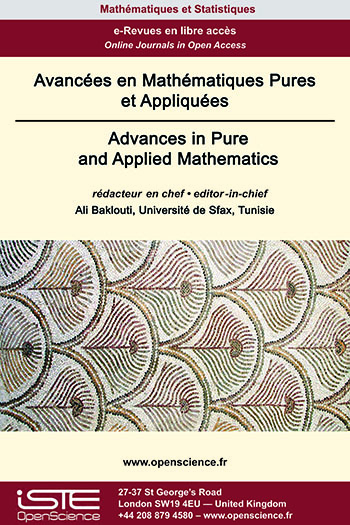

Mathematics > Home > Advances in Pure and Applied Mathematics > Issue
Let R ⊂ T be an extension of integral domains and ∗ be a semistar operation stable of finite type on R. We define a semistar operation ∗1 on T in the following way: for each nonzero T-submodule E of the quotient field K1 of T, let E∗1 = ∪ {E :K1 JT | J ∈ $$$\mathcal{F}$$$∗}, where K1 denotes the quotient field of T and $$$\mathcal{F}$$$∗ the localizing system associated to ∗. In this paper we investigate the basic properties of ∗1. Moreover, we show that the map $$$\varphi$$$ which associates to a semistar operation ∗ stable and of finite type on R, the semistar operation ∗1 is continuous. Furthermore, we give sufficient conditions for $$$\varphi$$$ to be a homeomorphism.
This paper is devoted to the study of the effects of indefinite weights on the following nonlinear Neumann problems
$$$
{(P^\pm)}
\begin{cases}
-\Delta u &= \lambda \, a(x) u \pm |u|^{p-1}u\ &\quad \hbox{in } \Omega \subset ℝ^N \\ \frac{\partial u}{\partial \nu} &=\ 0 \ & \hbox{on } \partial \Omega
\end{cases}$$$
The function $$$ a = a(x)$$$ is assumed to be continuous and sign-changing. Then the linear part has two sequences of eigenvalues. Our results establish a relation between the position of the parameter $$$\lambda$$$ and the number of nontrivial classical solutions of these problems. The proof combines spectral analysis tools, variational methods and the Clark multiplicity theorem.
In [7], A.Bahri introduced two topological invariants μ and τ to study the prescribed scalar curvature problem on standard spheres of high dimensions. In this paper we first extend μ and τ to the problem on general riemannian manifolds. Second we analyze, as suggested in [7], the relation between these two quantities and we prove under topological conditions that μ = τ.
Let d ≥ 1 be an integer and Kd be a contravariant functor from the category of subgroups of (ℤ/2ℤ)d to the category of graded and finite 𝔽2-algebras. In this paper, we generalize the conjecture of G. Carlsson [C3], concerning free actions of (ℤ/2ℤ)d on finite CW-complexes, by suggesting, that if Kd is a Gysin-(ℤ/2ℤ)d-functor (that is to say, the functor Kd satisfies some properties, see 2.2), then we have:
$$$\big(C_{d} \big): \; \underset{i \geq 0}{\sum}dim_{\mathbb{F}_{2}} \big(\mathcal{K}_{d}(0)\big)^{i} \geq 2^{d}$$$
We prove this conjecture for 1 ≤ d ≤ 3 and we show that, in certain cases, we get an independent proof of the following
results (for d = 3 see [C4]):
If the group (ℤ/2ℤ)d, 1 ≤ d ≤ 3, acts freely and cellularly on a finite CW-complex X, then $$${\underset{i \geq 0}{\sum}}dim_{\mathbb{F}_{2}}H^{i}(X;\; \mathbb{F}_{2}) \geq 2^{d}$$$

2025
Volume 25- 16
Issue 1 (January 2025)2024
Volume 24- 15
Issue 1 (January 2024)2023
Volume 23- 14
Issue 1 (January 2023)2022
Volume 22- 13
Issue 1 (January 2022)2021
Volume 21- 12
Issue 3 (Special AUS-ICMS 2020)2020
Volume 20- 11
Issue 1 (May 2020)